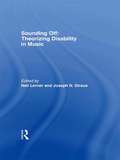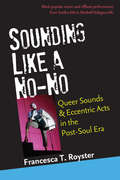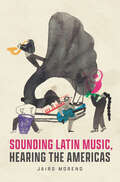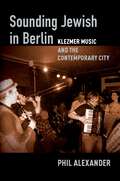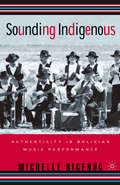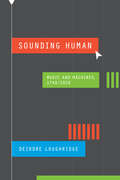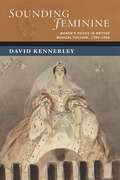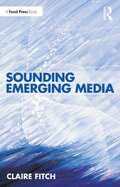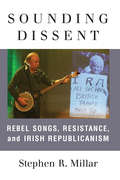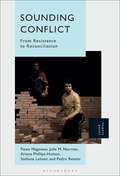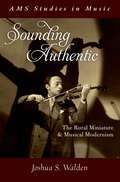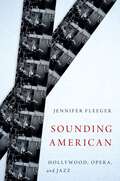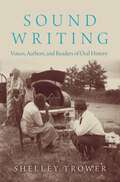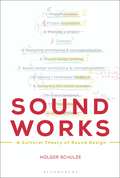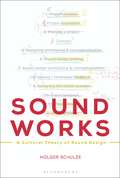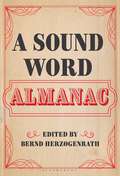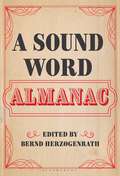- Table View
- List View
Sounding Off: Theorizing Disability In Music
by Neil Lerner Joseph StrausDisability, understood as culturally stigmatized bodily difference (including physical and mental impairments of all kinds), is a pervasive and permanent aspect of the human condition. While the biology of bodily difference is the proper study for science and medicine, the meaning that we attach to bodily difference is the proper study of humanists. The interdisciplinary field of Disability Studies has recently emerged to theorize social and cultural constructions of the meaning of disability. Although there has been an astonishing outpouring of humanistic work in Disability Studies in the past ten years, there has been virtually no echo in musicology or music theory. Sounding Off: Theorizing Disability in Music is the first book-length work to focus on the historical and theoretical issues of music as it relates to disability. It shows that music, like literature and the other arts, simultaneously reflects and constructs cultural attitudes toward disability. Sounding Off: Theorizing Disability in Music promises to be a landmark study for scholars and students of music, disability, and culture.
Sounding Off: Theorizing Disability In Music
by Neil Lerner Joseph N. StrausDisability, understood as culturally stigmatized bodily difference (including physical and mental impairments of all kinds), is a pervasive and permanent aspect of the human condition. While the biology of bodily difference is the proper study for science and medicine, the meaning that we attach to bodily difference is the proper study of humanists. The interdisciplinary field of Disability Studies has recently emerged to theorize social and cultural constructions of the meaning of disability. Although there has been an astonishing outpouring of humanistic work in Disability Studies in the past ten years, there has been virtually no echo in musicology or music theory. Sounding Off: Theorizing Disability in Music is the first book-length work to focus on the historical and theoretical issues of music as it relates to disability. It shows that music, like literature and the other arts, simultaneously reflects and constructs cultural attitudes toward disability. Sounding Off: Theorizing Disability in Music promises to be a landmark study for scholars and students of music, disability, and culture.
Sounding Like a No-No: Queer Sounds and Eccentric Acts in the Post-Soul Era
by Francesca T RoysterSounding Like a No-No traces a rebellious spirit in post–civil rights black music by focusing on a range of offbeat, eccentric, queer, or slippery performances by leading musicians influenced by the cultural changes brought about by the civil rights, black nationalist, feminist, and LGBTQ movements, who through reinvention created a repertoire of performances that have left a lasting mark on popular music. The book's innovative readings of performers including Michael Jackson, Grace Jones, Stevie Wonder, Eartha Kitt, and Meshell Ndegeocello demonstrate how embodied sound and performance became a means for creativity, transgression, and social critique, a way to reclaim imaginative and corporeal freedom from the social death of slavery and its legacy of racism, to engender new sexualities and desires, to escape the sometimes constrictive codes of respectability and uplift from within the black community, and to make space for new futures for their listeners. The book's perspective on music as a form of black corporeality and identity, creativity, and political engagement will appeal to those in African American studies, popular music studies, queer theory, and black performance studies; general readers will welcome its engaging, accessible, and sometimes playful writing style, including elements of memoir.
Sounding Latin Music, Hearing the Americas (Big Issues in Music)
by Jairo MorenoHow is Latin American music heard, by whom, and why? Many in the United States believe Latin American musicians make “Latin music”—which carries with it a whole host of assumptions, definitions, and contradictions. In their own countries, these expatriate musicians might generate immense national pride or trigger suspicions of “national betrayals.” The making, sounding, and hearing of “Latin music” brings into being the complex array of concepts that constitute “Latin Americanism”—its fissures and paradoxes, but also its universal aspirations. Taking as its center musicians from or with declared roots in Latin America, Jairo Moreno presents us with an innovative analysis of how and why music emerges as a necessary but insufficient shorthand for defining and understanding Latin American, Latinx, and American experiences of modernity. This close look at the growth of music-making by Latin American and Spanish-speaking musicians in the United States at the turn of the twenty-first century reveals diverging understandings of music’s social and political possibilities for participation and belonging. Through the stories of musicians—Rubén Blades, Shakira, Arturo O’Farrill and the Afro-Latin Jazz Orchestra, and Miguel Zenón—Sounding Latin Music, Hearing the Americas traces how artists use music to produce worlds and senses of the world at the ever-transforming conjunction of Latin America and the United States.
Sounding Latin Music, Hearing the Americas (Big Issues in Music)
by Jairo MorenoHow is Latin American music heard, by whom, and why? Many in the United States believe Latin American musicians make “Latin music”—which carries with it a whole host of assumptions, definitions, and contradictions. In their own countries, these expatriate musicians might generate immense national pride or trigger suspicions of “national betrayals.” The making, sounding, and hearing of “Latin music” brings into being the complex array of concepts that constitute “Latin Americanism”—its fissures and paradoxes, but also its universal aspirations. Taking as its center musicians from or with declared roots in Latin America, Jairo Moreno presents us with an innovative analysis of how and why music emerges as a necessary but insufficient shorthand for defining and understanding Latin American, Latinx, and American experiences of modernity. This close look at the growth of music-making by Latin American and Spanish-speaking musicians in the United States at the turn of the twenty-first century reveals diverging understandings of music’s social and political possibilities for participation and belonging. Through the stories of musicians—Rubén Blades, Shakira, Arturo O’Farrill and the Afro-Latin Jazz Orchestra, and Miguel Zenón—Sounding Latin Music, Hearing the Americas traces how artists use music to produce worlds and senses of the world at the ever-transforming conjunction of Latin America and the United States.
Sounding Jewish in Berlin: Klezmer Music and the Contemporary City
by Phil AlexanderHow can a traditional music with little apparent historical connection to Berlin become a way of hearing and making sense of the bustling German capital in the twenty-first century? In Sounding Jewish in Berlin, author Phil Alexander explores the dialogue between the city's contemporary klezmer scene and the street-level creativity that has become a hallmark of Berlin's decidedly modern urbanity and cosmopolitanism. By tracing how klezmer music engages with the spaces and symbolic meanings of the city, Alexander sheds light on how this Eastern European Jewish folk music has become not just a product but also a producer of Berlin. This engaging study of Berlin's dynamic Yiddish music scene brings together ethnomusicology, cultural studies, and urban geography to evoke the sounds, atmospheres, and performance spaces through which klezmer musicians have built a lively set of musical networks in the city. Transcending a restrictive framework that considers this music solely in the context of troubled German-Jewish history and notions of guilt and absence, Alexander shows how Berlin's current klezmer communitya diverse group of Jewish and non-Jewish performersimaginatively blend the genre's traditional musical language with characteristically local tones to forge an adaptable and distinctively twenty-first-century version of klezmer. Ultimately, the music's vital presence in Berlin is powerful evidence that if traditional music is to remain audible amid the noise of the urban, it must become a meaningful part of that noise.
Sounding Jewish in Berlin: Klezmer Music and the Contemporary City
by Phil AlexanderHow can a traditional music with little apparent historical connection to Berlin become a way of hearing and making sense of the bustling German capital in the twenty-first century? In Sounding Jewish in Berlin, author Phil Alexander explores the dialogue between the city's contemporary klezmer scene and the street-level creativity that has become a hallmark of Berlin's decidedly modern urbanity and cosmopolitanism. By tracing how klezmer music engages with the spaces and symbolic meanings of the city, Alexander sheds light on how this Eastern European Jewish folk music has become not just a product but also a producer of Berlin. This engaging study of Berlin's dynamic Yiddish music scene brings together ethnomusicology, cultural studies, and urban geography to evoke the sounds, atmospheres, and performance spaces through which klezmer musicians have built a lively set of musical networks in the city. Transcending a restrictive framework that considers this music solely in the context of troubled German-Jewish history and notions of guilt and absence, Alexander shows how Berlin's current klezmer communitya diverse group of Jewish and non-Jewish performersimaginatively blend the genre's traditional musical language with characteristically local tones to forge an adaptable and distinctively twenty-first-century version of klezmer. Ultimately, the music's vital presence in Berlin is powerful evidence that if traditional music is to remain audible amid the noise of the urban, it must become a meaningful part of that noise.
Sounding Indigenous: Authenticity in Bolivian Music Performance
by M. BigenhoSounding Indigenous explores the relations between music, people, and places through analysis of Bolivian music performances: by a non-governmental organization involved in musical activities, by a music performing ensemble, and by the people living in two rural areas of Potosi. Based on research conducted between 1993 and 1995, the book frames debates of Bolivian national and indigenous identities in terms of different attitudes people assume towards cultural and artistic authenticity. The book makes unique contributions through an emphasis on music as sensory experience, through its theorization of authenticity in relation to music, through its combined focus on different kinds of Bolivian music (indigenous, popular, avant-garde), through its combined focus on music performance and the Bolivian nation, and through its interpretation of local, national, and transnational fieldwork experiences.
Sounding Human: Music and Machines, 1740/2020 (New Material Histories of Music)
by Deirdre LoughridgeAn expansive analysis of the relationship between human and machine in music. From the mid-eighteenth century on, there was a logic at work in musical discourse and practice: human or machine. That discourse defined a boundary of absolute difference between human and machine, with a recurrent practice of parsing “human” musicality from its “merely mechanical” simulations. In Sounding Human, Deirdre Loughridge tests and traverses these boundaries, unmaking the “human or machine” logic and seeking out others, better characterized by conjunctions such as and or with. Sounding Human enters the debate on posthumanism and human-machine relationships in music, exploring how categories of human and machine have been continually renegotiated over the centuries. Loughridge expertly traces this debate from the 1737 invention of what became the first musical android to the creation of a “sound wave instrument” by a British electronic music composer in the 1960s, and the chopped and pitched vocals produced by sampling singers’ voices in modern pop music. From music-generating computer programs to older musical instruments and music notation, Sounding Human shows how machines have always actively shaped the act of music composition. In doing so, Loughridge reveals how musical artifacts have been—or can be—used to help explain and contest what it is to be human.
Sounding Human: Music and Machines, 1740/2020 (New Material Histories of Music)
by Deirdre LoughridgeAn expansive analysis of the relationship between human and machine in music. From the mid-eighteenth century on, there was a logic at work in musical discourse and practice: human or machine. That discourse defined a boundary of absolute difference between human and machine, with a recurrent practice of parsing “human” musicality from its “merely mechanical” simulations. In Sounding Human, Deirdre Loughridge tests and traverses these boundaries, unmaking the “human or machine” logic and seeking out others, better characterized by conjunctions such as and or with. Sounding Human enters the debate on posthumanism and human-machine relationships in music, exploring how categories of human and machine have been continually renegotiated over the centuries. Loughridge expertly traces this debate from the 1737 invention of what became the first musical android to the creation of a “sound wave instrument” by a British electronic music composer in the 1960s, and the chopped and pitched vocals produced by sampling singers’ voices in modern pop music. From music-generating computer programs to older musical instruments and music notation, Sounding Human shows how machines have always actively shaped the act of music composition. In doing so, Loughridge reveals how musical artifacts have been—or can be—used to help explain and contest what it is to be human.
Sounding Feminine: Women's Voices in British Musical Culture, 1780-1850 (New Cultural History of Music)
by David KennerleyBetween 1780 and 1850, the growing prominence of female singers in Britain's professional and amateur spheres opened a fraught discourse about women's engagement with musical culture. Protestant evangelical gender ideology framed the powerful, well-trained, and expressive female voice as a sign of inner moral corruption, while more restrained and delicate vocal styles were seen as indicative of the performer's virtuous femininity. Yet far from everyone was of this persuasion, and those from alternative class and religious milieux responded in more affirmative ways to the sound of professional female voices. The meanings listeners ascribed to women's voices reflect crucial developments in the musical world of the period, such as the popularity of particular genres with audiences of certain social backgrounds, and the reasons underpinning the development of prevalent types of nineteenth-century professional female vocality. Sounding Feminine traces the development of attitudes towards the female voice that have decisively shaped modern British society and culture. Arguing for the importance of the aural dimension of the past, author David Kennerley draws from a variety of fields-including sound studies, sensory histories, and gender theory-to examine how audiences heard different kinds of femininities in the voices of British female singers. Sounding Feminine explores the intense divisions over the "correct" use of the female voice, and the intricate links between gender, nationality, class, and religion in ascribing status, purpose, and morality to female singing. Through this lens, Kennerley also explores the formation of British middle-class identities and the cultural impact of the evangelical revival-deepening our understanding of this period of transformational change in British culture.
Sounding Feminine: Women's Voices in British Musical Culture, 1780-1850 (New Cultural History of Music)
by David KennerleyBetween 1780 and 1850, the growing prominence of female singers in Britain's professional and amateur spheres opened a fraught discourse about women's engagement with musical culture. Protestant evangelical gender ideology framed the powerful, well-trained, and expressive female voice as a sign of inner moral corruption, while more restrained and delicate vocal styles were seen as indicative of the performer's virtuous femininity. Yet far from everyone was of this persuasion, and those from alternative class and religious milieux responded in more affirmative ways to the sound of professional female voices. The meanings listeners ascribed to women's voices reflect crucial developments in the musical world of the period, such as the popularity of particular genres with audiences of certain social backgrounds, and the reasons underpinning the development of prevalent types of nineteenth-century professional female vocality. Sounding Feminine traces the development of attitudes towards the female voice that have decisively shaped modern British society and culture. Arguing for the importance of the aural dimension of the past, author David Kennerley draws from a variety of fields-including sound studies, sensory histories, and gender theory-to examine how audiences heard different kinds of femininities in the voices of British female singers. Sounding Feminine explores the intense divisions over the "correct" use of the female voice, and the intricate links between gender, nationality, class, and religion in ascribing status, purpose, and morality to female singing. Through this lens, Kennerley also explores the formation of British middle-class identities and the cultural impact of the evangelical revival-deepening our understanding of this period of transformational change in British culture.
Sounding Emerging Media
by Claire FitchSounding Emerging Media details a practice-based approach to sonic art and electroacoustic composition, drawing on methodologies inspired by the production of electronic literature, and game development. Using the structural concepts identified by Gilles Deleuze and Félix Guattari, the book is based around ideas related to labels such as Assemblage, Strata, Smooth and Striated Space, Temporal Space and, The Fold. The processes employed to undertake this research involved the creation of original texts, the development of frameworks for improvisation, the use of recordings within the process and implementation of techniques drawn from the practices of electroacoustic composition, and the use of ideas borrowed from electronic literature, publishing and game development. The results have helped to shape a compositional style which draws on these processes individually or collectively, drawing on practice often seen in game development, visual scores and composition using techniques found in electroacoustic music. Providing a journey through the landscape of emerging digital media, Sounding Emerging Media envisages a world where the composer/user/listener all become part of a continuum of collective artistry. This book is the ideal guide to the history and creation of audio for innovative digital media formats and represents crucial reading for both students and practitioners, from aspiring composers to experienced professionals.
Sounding Emerging Media
by Claire FitchSounding Emerging Media details a practice-based approach to sonic art and electroacoustic composition, drawing on methodologies inspired by the production of electronic literature, and game development. Using the structural concepts identified by Gilles Deleuze and Félix Guattari, the book is based around ideas related to labels such as Assemblage, Strata, Smooth and Striated Space, Temporal Space and, The Fold. The processes employed to undertake this research involved the creation of original texts, the development of frameworks for improvisation, the use of recordings within the process and implementation of techniques drawn from the practices of electroacoustic composition, and the use of ideas borrowed from electronic literature, publishing and game development. The results have helped to shape a compositional style which draws on these processes individually or collectively, drawing on practice often seen in game development, visual scores and composition using techniques found in electroacoustic music. Providing a journey through the landscape of emerging digital media, Sounding Emerging Media envisages a world where the composer/user/listener all become part of a continuum of collective artistry. This book is the ideal guide to the history and creation of audio for innovative digital media formats and represents crucial reading for both students and practitioners, from aspiring composers to experienced professionals.
Sounding Dissent: Rebel Songs, Resistance, and Irish Republicanism (Music and Social Justice)
by Stephen MillarThe signing of the Good Friday Agreement on April 10, 1998, marked the beginning of a new era of peace and stability in Northern Ireland. As the public has overwhelmingly rejected a return to the violence of the Troubles (1968–1998), loyalist and republican groups have sought other outlets to continue their struggle. Music has long been used to celebrate cultural identity in the North of Ireland: from street parades to football chants, and from folk festivals to YouTube videos, music facilitates the continuation of pre-Agreement identity narratives in a “post-conflict” era. Sounding Dissent draws on original in-depth interviews with Irish republican musicians, contemporary audiences, and former paramilitaries, as well as diverse historical and archival material, including songbooks, prison records, and newspaper articles, to understand the history of political violence in Ireland. The book examines the hagiographic potential of rebel songs to memorialize a pantheon of republican martyrs, and demonstrates how musical performance and political song not only articulate experiences and memories of oppression and violence, but play a central role in the reproduction of conflict and exclusion in times of peace.
Sounding Conflict: From Resistance to Reconciliation
by Fiona Magowan Pedro Rebelo Stefanie Lehner Julie M. Norman Ariana Phillips-HuttonSound, music and storytelling are important tools of resistance, resilience and reconciliation in creative practice from protracted conflict to post-conflict contexts. When they are used in a socially engaged participatory capacity, they can create counter-narratives to conflict. Based on original research in three continents, this book advances an interdisciplinary, comparative approach to exploring the role of sonic and creative practices in addressing the effects of conflict. Each case study illustrates how participatory arts genres are variously employed by musicians, arts facilitators, theatre practitioners, community activists and other stakeholders as a means of 'strategic creativity' to transform trauma and promote empowerment. This research further highlights the complex dynamics of delivering and managing creativity among those who have experienced violence, as they seek opportunities to generate alternative arenas for engagement, healing and transformation.
Sounding Conflict: From Resistance to Reconciliation
by Fiona Magowan Pedro Rebelo Stefanie Lehner Julie M. Norman Ariana Phillips-HuttonSound, music and storytelling are important tools of resistance, resilience and reconciliation in creative practice from protracted conflict to post-conflict contexts. When they are used in a socially engaged participatory capacity, they can create counter-narratives to conflict. Based on original research in three continents, this book advances an interdisciplinary, comparative approach to exploring the role of sonic and creative practices in addressing the effects of conflict. Each case study illustrates how participatory arts genres are variously employed by musicians, arts facilitators, theatre practitioners, community activists and other stakeholders as a means of 'strategic creativity' to transform trauma and promote empowerment. This research further highlights the complex dynamics of delivering and managing creativity among those who have experienced violence, as they seek opportunities to generate alternative arenas for engagement, healing and transformation.
Sounding Authentic: The Rural Miniature and Musical Modernism (AMS Studies in Music)
by Joshua S. WaldenSounding Authentic considers the intersecting influences of nationalism, modernism, and technological innovation on representations of ethnic and national identities in twentieth-century art music. Author Joshua S. Walden discusses these forces through the prism of what he terms the "rural miniature": short violin and piano pieces based on folk song and dance styles. This genre, mostly inspired by the folk music of Hungary, the Jewish diaspora, and Spain, was featured frequently on recordings and performance programs in the early twentieth century. Furthermore, Sounding Authentic shows how the music of urban Romany ensembles developed into nineteenth-century repertoire of virtuosic works in the style hongrois before ultimately influencing composers of rural miniatures. Walden persuasively demonstrates how rural miniatures represented folk and rural cultures in a manner that was perceived as authentic, even while they involved significant modification of the original sources. He also links them to the impulse toward realism in developing technologies of photography, film, and sound recording. Sounding Authentic examines the complex ways the rural miniature was used by makers of nationalist agendas, who sought folkloric authenticity as a basis for the construction of ethnic and national identities. The book also considers the genre's reception in European diaspora communities in America where it evoked and transformed memories of life before immigration, and traces how many rural miniatures were assimilated to the styles of American popular song and swing. Scholars interested in musicology, ethnography, the history of violin performance, twentieth-century European art music, the culture of the Jewish Diaspora and more will find Sounding Authentic an essential addition to their library.
Sounding American: Hollywood, Opera, and Jazz (Oxford Music / Media)
by Jennifer FleegerSounding American: Hollywood, Opera, and Jazz tells the story of the interaction between musical form, film technology, and ideas about race, ethnicity, and the nation during the American cinema's conversion to sound. Contrary to most accepted narratives about the conversion, which tend to explain the competition between the Hollywood studios' film sound technologies in qualitative and economic terms, this book argues that the battle between disc and film sound was waged primarily in an aesthetic realm. Opera and jazz in particular, though long neglected in studies of the film score, were extremely important in defining the scope of the American soundtrack, not only during the conversion, but also once sound had been standardized. Examining studio advertisements, screenplays, scores, and the films themselves, author Jennifer Fleeger concentrates on the interactions between musical form and film technology, arguing that each of the major studios appropriated opera and jazz in a unique way in order to construct its own version of an ideal American voice. Traditional histories of Hollywood film music have tended to concentrate on the unity of the score, a model that assumes a passive spectator. Sounding American claims that the classical Hollywood film is essentially an illustrated jazz-opera with a musical structure that encourages an active form of listening and viewing in order to make sense of what is ultimately a fragmentary text.
Sound Writing: Voices, Authors, and Readers of Oral History (Oxford Oral History Series)
by Shelley TrowerThe concept that oral history can give voice to people or allow "hidden voices" to become part of history is one of its most celebrated achievements. However, the standard practice of transcribing or summarizing interviews has meant that oral historians have had to grapple with questions of how to translate the oral into written form. What is lost or gained during this process of mediation? These re-creations can be wonderful and illuminating works of scholarship and art, and this book explores a wide range of the different forms they have taken-from John and Alan Lomax's transcriptions of African American songs for the Federal Writers Project to Svetlana Alexievich's polyphonic novels. Such works can give their subjects the necessary latitude to convey their narratives on their own terms, but there is also, always, the danger that their voices will be distorted or lost during the process of mediation. Sound Writing offers a thorough review of the varying arguments about editing for transcription and publication and reflects on how digital technologies enable much wider access to "raw" oral data. It examines how oral histories are co-created by speakers, the authors who mediate them, and readers, and it brings into sharp focus questions about how memory takes on subjective, narrative form. Finally, it examines the interplay between written literature and sound recordings, or orality, using a diverse range of examples-from the work of William Wordsworth and George Ewart Evans to Studs Terkel, Alex Haley, Luisa Passerini, Amrit Wilson, and Stacy Zembrzycki. As an interdisciplinary study, Sound Writing takes a broad approach to the written word to encompass not only transcriptions and other texts derived from oral history interviews but also literary precursors such as epic poetry and folklore, along with various related textual forms such as biography, autobiography, and blogs. It argues that the recording of oral traditions in print by poets, folklorists, anthropologists, and postcolonial writers is comparable to practices of recording, transcribing, and publishing familiar to oral historians. Literary genres have long influenced oral history narratives, and, in turn, oral history has helped shape literary forms.
Sound Writing: Voices, Authors, and Readers of Oral History (Oxford Oral History Series)
by Shelley TrowerThe concept that oral history can give voice to people or allow "hidden voices" to become part of history is one of its most celebrated achievements. However, the standard practice of transcribing or summarizing interviews has meant that oral historians have had to grapple with questions of how to translate the oral into written form. What is lost or gained during this process of mediation? These re-creations can be wonderful and illuminating works of scholarship and art, and this book explores a wide range of the different forms they have taken-from John and Alan Lomax's transcriptions of African American songs for the Federal Writers Project to Svetlana Alexievich's polyphonic novels. Such works can give their subjects the necessary latitude to convey their narratives on their own terms, but there is also, always, the danger that their voices will be distorted or lost during the process of mediation. Sound Writing offers a thorough review of the varying arguments about editing for transcription and publication and reflects on how digital technologies enable much wider access to "raw" oral data. It examines how oral histories are co-created by speakers, the authors who mediate them, and readers, and it brings into sharp focus questions about how memory takes on subjective, narrative form. Finally, it examines the interplay between written literature and sound recordings, or orality, using a diverse range of examples-from the work of William Wordsworth and George Ewart Evans to Studs Terkel, Alex Haley, Luisa Passerini, Amrit Wilson, and Stacy Zembrzycki. As an interdisciplinary study, Sound Writing takes a broad approach to the written word to encompass not only transcriptions and other texts derived from oral history interviews but also literary precursors such as epic poetry and folklore, along with various related textual forms such as biography, autobiography, and blogs. It argues that the recording of oral traditions in print by poets, folklorists, anthropologists, and postcolonial writers is comparable to practices of recording, transcribing, and publishing familiar to oral historians. Literary genres have long influenced oral history narratives, and, in turn, oral history has helped shape literary forms.
Sound Works: A Cultural Theory of Sound Design
by Holger SchulzeWhat is sound design? What is its function in the early 21st century and into the future?Sound Works examines these questions in four parts: Part 1, "Why This Sound?", presents an overview of the modern history of sound design. Part 2 is highly visual and provides a glance onto a sound designer's workbench and the current state of "Sonic Labor." Part 3 uses cultural analysis to explore our contemporary "Living with Sounds." The final and fourth part then proposes a series of anthropological and political interpretations of how “Sound Works” today. This book is not a manual on sound design; it instead argues for a cultural theory of sound design for sound designers and sound artists, for clients who commission a sound design and for researchers in the fields of sound studies, design research, and cultural studies
Sound Works: A Cultural Theory of Sound Design
by Holger SchulzeWhat is sound design? What is its function in the early 21st century and into the future?Sound Works examines these questions in four parts: Part 1, "Why This Sound?", presents an overview of the modern history of sound design. Part 2 is highly visual and provides a glance onto a sound designer's workbench and the current state of "Sonic Labor." Part 3 uses cultural analysis to explore our contemporary "Living with Sounds." The final and fourth part then proposes a series of anthropological and political interpretations of how “Sound Works” today. This book is not a manual on sound design; it instead argues for a cultural theory of sound design for sound designers and sound artists, for clients who commission a sound design and for researchers in the fields of sound studies, design research, and cultural studies
A Sound Word Almanac
by Bernd HerzogenrathThis almanac of sound words important to artists and scholars highlights words that expand the way we speak (and write) about sonic experiences.Why write about sound, and how? If sonic philosophy is the attempt "to think about sound by philosophical means," then a metaphilosophical debate appears almost immediately on the horizon: What is called for is an understanding about sound and language, but also about the preconditions of musical understanding. What is at stake is the question of language and sound, as well as expanding how we speak about sonic experience.This almanac tackles these questions from artistic, experimental and personal perspectives. An assemblage of nearly 70 practitioners and theoreticians, artists and scholars offer their favorite 'sound word.' These sound words are onomatopoetical, mythological, practical; words of personal importance to the artists and their craft; words from their memory, related to sound. Many entries are not in English – some are untranslatable – and all are accompanied by a personal, explanatory, poetic entry. These are words that have the potential to change our perspective on listening-musicking-thinking.
A Sound Word Almanac
This almanac of sound words important to artists and scholars highlights words that expand the way we speak (and write) about sonic experiences.Why write about sound, and how? If sonic philosophy is the attempt "to think about sound by philosophical means," then a metaphilosophical debate appears almost immediately on the horizon: What is called for is an understanding about sound and language, but also about the preconditions of musical understanding. What is at stake is the question of language and sound, as well as expanding how we speak about sonic experience.This almanac tackles these questions from artistic, experimental and personal perspectives. An assemblage of nearly 70 practitioners and theoreticians, artists and scholars offer their favorite 'sound word.' These sound words are onomatopoetical, mythological, practical; words of personal importance to the artists and their craft; words from their memory, related to sound. Many entries are not in English – some are untranslatable – and all are accompanied by a personal, explanatory, poetic entry. These are words that have the potential to change our perspective on listening-musicking-thinking.
